#1 of 67 produced
Explore tagged Tumblr posts
Text







mkiv
1 note
·
View note
Text
Good News - July 15-21
Like these weekly compilations? Tip me at $kaybarr1735! (Or check out my new(ly repurposed) Patreon!)
1. Thai tiger numbers swell as prey populations stabilize in western forests

“The tiger population density in a series of protected areas in western Thailand has more than doubled over the past two decades, according to new survey data. […] The most recent year of surveys, which concluded in November 2023, photographed 94 individual tigers, up from 75 individuals in the previous year, and from fewer than 40 in 2007. […] A total of 291 individual tigers older than 1 year were recorded, as well as 67 cubs younger than 1 year.”
2. Work starts to rewild former cattle farm

“Ecologists have started work to turn a former livestock farm into a nature reserve [… which] will become a "mosaic of habitats" for insects, birds and mammals. [… R]ewilding farmland could benefit food security locally by encouraging pollinators, improving soil health and soaking up flood water. [… “N]ature restoration doesn't preclude food production. We want to address [food security] by using nature-based solutions."”
3. Harnessing ‘invisible forests in plain view’ to reforest the world

“[… T]he degraded land contained numerous such stumps with intact root systems capable of regenerating themselves, plus millions of tree seeds hidden in the soil, which farmers could simply encourage to grow and reforest the landscape[….] Today, the technique of letting trees resprout and protecting their growth from livestock and wildlife [… has] massive potential to help tackle biodiversity loss and food insecurity through resilient agroforestry systems. [… The UN’s] reported solution includes investing in land restoration, “nature-positive” food production, and rewilding, which could return between $7 and $30 for every dollar spent.”
4. California bars school districts from outing LGBTQ+ kids to their parents

“Gov. Gavin Newsom signed the SAFETY Act today – a bill that prohibits the forced outing of transgender and gay students, making California the first state to explicitly prohibit school districts from doing so. […] Matt Adams, a head of department at a West London state school, told PinkNews at the time: “Teachers and schools do not have all the information about every child’s home environment and instead of supporting a pupil to be themselves in school, we could be putting them at risk of harm.””
5. 85% of new electricity built in 2023 came from renewables

“Electricity supplied by renewables, like hydropower, solar, and wind, has increased gradually over the past few decades — but rapidly in recent years. [… C]lean energy now makes up around 43 percent of global electricity capacity. In terms of generation — the actual power produced by energy sources — renewables were responsible for 30 percent of electricity production last year. […] Along with the rise of renewable sources has come a slowdown in construction of non-renewable power plants as well as a move to decommission more fossil fuel facilities.”
6. Deadly cobra bites to "drastically reduce" as scientists discover new antivenom

“After successful human trials, the snake venom antidote could be rolled out relatively quickly to become a "cheap, safe and effective drug for treating cobra bites" and saving lives around the globe, say scientists. Scientists have found that a commonly used blood thinner known as heparin can be repurposed as an inexpensive antidote for cobra venom. […] Using CRISPR gene-editing technology […] they successfully repurposed heparin, proving that the common blood thinner can stop the necrosis caused by cobra bites.”
7. FruitFlow: a new citizen science initiative unlocks orchard secrets

“"FruitWatch" has significantly refined phenological models by integrating extensive citizen-sourced data, which spans a wider geographical area than traditional methods. These enhanced models offer growers precise, location-specific predictions, essential for optimizing agricultural planning and interventions. […] By improving the accuracy of phenological models, farmers can better align their operations with natural biological cycles, enhancing both yield and quality.”
8. July 4th Means Freedom for Humpback Whale Near Valdez, Alaska

“The NOAA Fisheries Alaska Marine Mammal Stranding Hotline received numerous reports late afternoon on July 3. A young humpback whale was entangled in the middle of the Port of Valdez[….] “The success of this mission was due to the support of the community, as they were the foundation of the effort,” said Moran. [… Members of the community] were able to fill the critical role of acting as first responders to a marine mammal emergency. “Calling in these reports is extremely valuable as it allows us to respond when safe and appropriate, and also helps us gain information on various threats affecting the animals,” said Lyman.”
9. Elephants Receive First of Its Kind Vaccine

“Elephant endotheliotropic herpesvirus is the leading cause of death for Asian elephants (Elephas maximus) born in facilities in North America and also causes calf deaths in the wild in Asia. A 40-year-old female received the new mRNA vaccine, which is expected to help the animal boost immunity[….]”
10. Conservation partners and Indigenous communities working together to restore forests in Guatemala

“The K’iche have successfully managed their natural resources for centuries using their traditional governing body and ancestral knowledge. As a result, Totonicapán is home to Guatemala’s largest remaining stand of conifer forest. […] EcoLogic has spearheaded a large-scale forest restoration project at Totonicapán, where 13 greenhouses now hold about 16,000 plants apiece, including native cypresses, pines, firs, and alders. […] The process begins each November when community members gather seeds. These seeds then go into planters that include upcycled coconut fibers and mycorrhizal fungi, which help kickstart fertilization. When the plantings reach about 12 inches, they’re ready for distribution.”
July 8-14 news here | (all credit for images and written material can be found at the source linked; I don’t claim credit for anything but curating.)
#hopepunk#good news#tiger#thailand#habitat#rewilding#food insecurity#forest#reforestation#california#lgbtq#lgbtqia#students#law#trans rights#gay rights#renewableenergy#clean energy#snake#medicine#crispr#citizen science#farming#whale#humpback whale#elephant#vaccine#alaska#guatemala#indigenous
465 notes
·
View notes
Text
body favors | masterlist <3
✩ pairing: rafe cameron x singer!reader
✩ summary: up and coming pop star and producer y/n goes viral after being spotted with infamous hothead rich boy rafe cameron and dropping her debut single that may or may not be about him (it is).
✩ ongoing (mini hiatus)


✩ characters’ profiles
✩ the prologue
✩ chapter 1
✩ chapter 2
✩ chapter 3
✩ chapter 4
✩ chapter 5
✩ chapter 6
✩ chapter 7
✩ chapter 8
✩ chapter 9
✩ chapter 10
✩ chapter 11
✩ chapter 12
✩ chapter 13
✩ chapter 14
✩ chapter 15
✩ chapter 16
✩ chapter 17
✩ chapter 18
✩ chapter 19
✩ chapter 20
✩ chapter 21
✩ chapter 22
✩ chapter 23
✩ chapter 24
✩ chapter 25
✩ chapter 26
✩ chapter 27
✩ chapter 28
✩ chapter 29
✩ chapter 30
✩ chapter 31
✩ chapter 32
✩ chapter 33
✩ chapter 34
✩ chapter 35
✩ chapter 36
✩ chapter 37
✩ chapter 38
✩ chapter 39
✩ chapter 40
✩ chapter 41
✩ chapter 42
✩ chapter 43
✩ chapter 44
✩ chapter 45
✩ chapter 46
✩ chapter 47
✩ chapter 48
✩ chapter 49
✩ chapter 50
✩ chapter 51
✩ chapter 52
✩ chapter 53
✩ chapter 54
✩ chapter 55
✩ chapter 56
✩ chapter 57
✩ chapter 58
✩ chapter 59
✩ chapter 60
✩ chapter 61
✩ chapter 62
✩ chapter 63
✩ chapter 64
✩ chapter 65
✩ chapter 66
✩ chapter 67
✩ chapter 68
✩ chapter 69
✩ chapter 70

#body favors masterlist#rafe x black reader#song based fic#obx au#body favors smau#rafe cameron x black!reader#fic based on a song#outer banks smau#body favors au#rafe x black!reader#obx smau#masterlist#rafe cameron x black reader#outer banks au#rafe cameron x black oc
158 notes
·
View notes
Note
that post made me curious. how many hours of television do you think you've written in your life?
Let's see. I'll count cowritten and written because, well, the work is the work. I won't count stuff I completely rewrote but didn't take credit on, or stuff that was never shot or never aired, so...
1 ep of TNG at 46 minutes (about) - 46
37 eps of DS9 at 46 - 1702 min (I wrote a lot more than that, but good enough)
Futuresport, TV movie - 91 minutes
Dead Zone, 1 ep - 43 minutes
Twilight Zone, 1 ep - 22 minutes or so
Andromeda, 9 eps - 43 minutes - 367 (which is a very low estimate)
Dresden Files, 3 eps but it's complicated so let's call this - 168 minutes
I'm not going to count Scarlett since it didn't air.
The 4400, 2 eps, 41 minutes each - 82 minutes
Riverworld, 2 parts, 189
The Gates, 2 eps, 43 each, 86 minutes
Star-Crossed, 2 eps, 42 each, 84 minutes
Alphas, 5 eps, 44ish minutes, 220
Elementary, 16 eps, 44 minutes each, 704 (minimum)
Prodigal Son, 1 ep, partially shot, never finished, never aired, 0
The Irrational, 5 eps, 42 minutes, 210...
So, 87-90 episodes (depending how you count Riverworld), adding up to 4014 minutes which is about 67 hours.
Only counting produced and aired credits and not things that were either never produced or never aired. If I counted those, it'd be at least 80 hours. Plus all the rewrites and polishes, which would bring it to around 100 or so.
Not bad.
Though I'll happily do more.
Coincidently, as I write this, AWOLNATON "I Am" is playing in my headphones:
"Maybe all of these things made me who I am And I am Only lookin' up when my head's down Ooh, veins are glistening So thanks a lot for listening (Aaahh) You might also like I guess I wanted, I guess I wanted I just want you to know"
(I didn't count the episode of "Good News, Bad News," I wrote. It was a UCLA student produced sitcom that aired on some University exclusive channels. That would be 22 more minutes. But I feel like that's a stretch and it's not on IMDB so...)
70 notes
·
View notes
Text










We've been discussing on rallies too much these few times on the page thus today, we're switching it up abit and we'll talk about the car that spawned a class of its own and also the car that shaped Ford itself, the Ford Mustangs.
Pics from left to right, top to bottom in zigzag pattern: 1964 & 1/2 Mustang, original '67 Steve Mcqueen used Mustang Fastback for the movie "Bullit" being displayed at a museum, '68 GT350, '69 Boss 302, '85 SVO "Foxbody", '90 SVT Cobra "Foxbody", '02 "New Edge" "Terminator" Cobra SVT, '07 Mustang GT, '15 Mustang GT, '23 Dark Horse
During the height of the muscle car prowess of the early 60s, woman rights were also becoming ever more relaxing and thus to capitalize on the market, Ford in 1961 had decided to build a car where a female driver can also have fun with a smaller sports car rather than driving a big barge and praying it performs to be sporty. By 1962, the rolling prototype with an engine was made and it was named the "Mustang I". There was various differences on how the name came about as some had said that it was named that as a homage to the legendary WWII USAAF P-51 Mustang or it was named after the Mustang horse. Regardless, the prototype was a success and the car would be slated to be produced in 1985.
Ford would produce the vehicle in 1964 as the 1st gen and it would comprise alot of parts from the already existing Falcons and Fairlanes. However, due to some.. Oddities, Ford would name the car as the "64 & 1/2" model. Regardless, the car was initially just issued with to be sold with an inline-6 engine but would soon stuff the V8 engine into the chassis. With the 289ci 4.7L V8, the top-of-the-line Mustang GT could do 210hp and it drives better than the Fairlane and Falcons due to its shorter length and way lighter weight. To sweeten the pot for buyers, in 1965 and with the collab between Ford and Shelby, Shelby would be the 1st outside dealers and companies to gain access to the Mustang and modified it and sell it as their own modified vehicle thru Ford dealers and it became the GT350. Shelby would take the base 289ci engine and fettle with it to produce approx 280hp. Car would be a massive success as it sold just about 1 million models in just a span of 3 years.
In 1966, Ford decided to improve the design of the car and instead of making two different coupe styles, they'll make only one coupe style and the "Fastback" model became the standard following on. By making the restyle wider, it could fit bigger engines now also which also improve stability even more. Ford would initially roll out the model with the 289ci still but Ford would also push the newer 302ci 4.9L V8 model engine in 1968 for the middle models. With the 289ci, it made approx 210hp and with the 302ci, it made approx 230hp. However, Shelby once again was not done with it so he started to modify it again and this time, under Shelby's fettling has 3 models starting with the GT350 line, the GT500 line and the "GT350 Hertz" edition. The GT350 originally had the modified 289ci and under Shelby's hands, it made 305hp. To sell the point that Ford made a great car for racing, they oddly tried to sell it to Hertz Rental and worked out a deal to sell some Shelby-made GT350s as fleet car to Hertz for people to rent and "have fun with". Hertz indeed ordered over a 1,000 GT350s and it became a special vehicle where customers would indeed rent the car and use it for SCCA events or even in grassroot drag racing events. Carroll Shelby however, wasn't done and he still wanted to have his fun so by 1967, he decided to toss in the 427ci 7L "big block Ford" V8 into the Mustang chassis and it became a ripper and calling it the GT500. Shelby sold about 2500 just for the '67 GT500 alone. He still wasn't done yet and the following year, he yet again upgraded the Mustang and it has the 428 "Cobra Jet" engine in it and despite Ford reporting it to be only about 355hp, people have reported the '68 GT500KR to be at 420hp at least.
1969 would follow the same design cues of the '67 model but now, Ford had inkling to break off with Shelby thus trying to go their own way, they decided to launch 3 different models for their sports models being the Mach 1, Boss 302 and Boss 429. With the Mach 1 being the base of the model's sports lineup, it came with the 351ci 5.7L V8 making 290hp and it was rapid of itself. Chevrolet would build the Camaro to fight with the Mustang in the pony car segment and Chevy with their better small block V8, it performed way better on the tracks and thus, to test out better engines, the "BOSS" variants were made to homologate these engines for racing, especially the SCCA Trans-Am series. Thus, with the 302, Ford used a modified 289ci "HiPo" engine, bore it out to 4.9L and with better heads, made it produce 295hp and reved higher than before. To beat Chevy's big block and also Dodge's 440 Magnum, Ford would once again improve their 427ci big block into a 429ci variant for NASCAR racing and yet again, they stuffed that into the Mustang and turned it to the Boss 429. With the 429ci V8, the Boss 429 made approx 370hp and it was the fastest of the entire line. Shelby would also make a few GT350s with the 1969 model but it wouldn't last long as it was made only for a year as Shelby and Ford had a fallout in 1970 and broke ties. The '69 model was made from 1969-1973 and approx another 2 million or so was made in total and sold.
(Can't place anymore pics due to the cap rate. Sorry)
In the mid-1970s, there's a problem worldwide. The oil crisis of 1973 was felt by all nations due to the Middle East fuel producing league, OPEC's plays. OPEC placed an embargo on all nations that supported Israel due to the outbreak of the Yom Kippur War and America was hit the worst due to all of their cars having massive V8s. Ford was also trying to push the Mustang to be smaller as by 1971, the Mustang was getting bigger and fatter thus ruining handling despite the increase in horsepower and luxury and with that, sales starting to drop drastically and for the 2nd gen, Lee Ioccoca, the new Ford boss of 1970 decided to downscale the chassis and use the Ford Pinto and Maverick chassis as a stepup. With the fuel crisis hitting in 1973, Ford had to downscale all their engines also and with that, Ford called it the Mustang II. This time to beat the fuel crisis, the inline-6 didn't become the base engine anymore but instead, the Pinto's 2.3L inline-4 engine became the base engine for the base model. Ford would offer the V8 option also but the 302ci V8 was the only option but this time, the V8 was seriously throttled to just 145hp. Despite journalists and reviewers raving about the car, people in the later years would hate on it massively due to the woeful performance and the incoming foreign imports were better than the Mustang II in performance. Despite all that, Ford sold over 1 million of the Mustang II that was made from 1974-1978.
In 1977, the Mustang II was losing out sales to the foreign imports like the Datsun Fairlady Z and to claw back sales, Ford decided to claw back sales by dumping the fugly design of the Mustang II and instead redesign everything to be as contemporary as they can that followed foreign import styles and would use the base of the Ford Fairmont. Soon by 1978, the design was done and was to start production in 1979 as the 3rd gen Mustang now being nicknamed "Foxbody". The initial Foxbody came with multiple engine options too such as the 2.3L inline-4, couple of V6s and a new 255ci 4.2L V8 as the fuel crisis still hasn't recovered much yet. Even with the V8 at this point, the 255ci only made approx 150hp at max which isn't good but with the better chassis now, the car was still a hit and immediately, it made a name for itself. 1983 saw the improved Foxbody and finally, the 302ci V8 came back into the lineup and the power was rated at 175hp. Ford, wanting a full performance model after the fuel crisis now and also with Shelby gone for almost a decade, they had to set up their own race development branch and they decided to call it the "Special Vehicle Operations", SVO for short and the Foxbody Mustang would be the first target. Instead of using the 302ci V8, SVO would take the 2.3L inline-4, turbocharge it and stuff it into the car which makes 205hp and the car model would be called the "Mustang SVO". The SVO would be made from 1984-1986. Despite the strong start and selling over 100,000 models per year, Ford had calculated that it wasn't enough and had planned to replace it with the new Mazda-derived Ford Probe and kill the Mustang but the Probe was soo shit that people clamoured for more Mustang. Ford would continue to produce the Foxbody and with the 90s coming in, it would see its 3rd facelift for the 1987 model. The 302ci V8 engine would be back in the lineup as the only V8 option and now, its labelled as a "5.0" despite being only 4.9L but regardless of the scam, power figures were back to pre-fuel crisis level at 205hp. To continue the previous legacy of the SVO, the SVO team, now renamed to the "Special Vehicles Team", SVT, would once again tinker on the facelifted Foxbody but this time using the 302ci V8 as their base engine to work with and from the unit, they managed to squeeze out 30 more hp to a total figure of 235hp and from there, they named it as the "SVT Cobra". The SVT Cobra also came with uprated suspension, sway bars that made it extremely potent on the race tracks and the streets. In total, 4993 SVT Cobras would be made by SVT and the 3rd facelift Foxbody would be made from 1987-1993. In total, 2.5million Foxbody Mustangs were made.
With the 90s now in full swing, Ford also decided to upgrade and redesign their Mustang and from the Foxbody base, they wrapped the underpinnings with a modern bodyshell instead of the 80s angular design and called it the SN95. Car started production in 1993 with the 3.8L V6 as the base model which produced 145hp. The subsequent GT model would have the 302ci V8 which produced 215hp. 1996 would see a shift in engine as Ford pushed out the modular SOHC V8 starting with the 4.6L. It made 215hp at the start of its introduction and in 1998, it saw an increase of hp to 225hp. SVT could also fettle with the car and with the 1994-1996 model, it used the 302ci V8 and SVT pushed the engine to 240hp and retained the Cobra name. For the 1996-1998 model, SVT took the base 4.6L V8 and installed another cam on it and in return bumped the power up to 305hp. For 1999, Ford updated the SN95 to a sleeker look and Ford would recode it to the SN99 and nickname it the "New Edge" following their design concept name. Both the V6 and SOHC V8 would see power increases at 190 and 260hp respectively. The '99 SVT Cobra also saw a power upgrade with their DOHC V8 now producing 320hp as claimed but there was a problem... When customers bought the '99 SVT Cobra, they felt the car to be slightly off from the figures Ford gave and upon their own private testing, they found that the SVT Cobra only made 285hp, a stark contrast of what was claimed by Ford thus after many people complaining about the same issue, Ford halted sales of the '99 SVT Cobra for abit and fixed the issue for it to be resold in 2001 again. By 2003, Ford had decided to release a new design for the Mustang and to send off the SN99, SVT sent the SN99 off with a bang and this time, they changed the base block of the DOHC modular V8 from an aluminium block to iron block and slap a supercharger on it which now made 390hp and to intimidate Chevy and GM in particular, SVT would also nickname it the "Terminator". 2004 would see the final kill off for the SN99 platform with the Cobra R where the styling was ever for aggressive and have a wing as stock option but power output stays the same with the base Cobra. In total, Ford made 1.56 million 4th gen Mustangs from 1994-2003.
Ford made the 5th gen Mustang starting from 2005 and Ford codenamed it the S197. To complement the car, Ford would change its engine lineups also with the base V6 changing to a newer 4L version that produces 220hp and for the GT version, the modular SOHC V8 would be retained but now pushing 300hp. With Shelby now working with Ford again in 2005, Shelby started to modify the Mustang again but this time, there isn't a GT350 version but straight up started with the GT500. Production of the GT500 started in 2007 and it used the same engine from the SVT Cobra but this time, Shelby managed to maximize its power and pushed the engine to 500hp. Not only was this generation the start of the massive power coming from the Mustangs, its also one of the few models in America that kicked off the "new retro" look which would soon kick off the other companies to follow the same movement like the 5th gen Chevrolet Camaro and the Dodge Challenger. Ford would remodel the S197 into the II variant with a newer look in 2010 and for the 1st year of the facelift, the 4L V6 was still being used but by 2011, Ford swapped it to the Duratec 3.7L V6 which made 305hp. The GT stayed the same as the 4.6L "Termi" V8 was used but power was yet again increased to 315hp. Same as the base model, the GT model also saw a new engine change and this time, its a whole new V8 based on the Ford Modular V8 platform, this time with a 5L DOHC V8 nicknamed as the "Coyote" and with that unit, it would produce 415hp. Ford would also roll out a refreshed Boss 302 with the S197-II as its base and as a limited model. With the same Coyote V8 used, Ford bumped the power up to 444hp. Shelby would also take a few of the S197 and turn it into the Shelby GT500 with a 5.4L V8 coupled to a supercharger making 540hp. In 2013, Shelby once again upped the ante and swapped the engine again and this time using a 5.8L "Trinity" V8 with a supercharger still and this time making over 650hp, the fastest production muscle car of that time. In total, the S197 sold over 1.1 million units total with a production run from 2005-2014.
By 2015, Ford would roll out the 6th gen Mustang with the codename S550 and this time, it has a sleeker design and also, new chassis comes new ideas. For the basic model, Ford would this time introduce their new 2.3L Ecoboost inline-4 turbo engine for the Mustang which makes 310hp, a middle pack V6 model still using the Cyclone unit which made 300hp and the GT which used the Coyote V8 unit making 435hp. However, the V6 would be discontinued in 2018 during the facelift year and the Ecoboost became the only base model left. The GT would also see a power increase from the 2018 facelift model at 460hp. Shelby once again turned heads with the Mustang that now instead of making the Shelby GT product line as a pure upgrade of the Mustang GT, Shelby decided to make the Mustang into a track machine and did that they did. Shelby, instead of using a typical rocker arm V8, bought a V8 from a Ferrari California to test it and figure out how powerful it was. Upon liking the flat-plane crank V8, they decided to ask Ford for assistance to build such engine and Ford took the challenge and by 2014 made a 5.2L flat-plane crank V8 nicknamed as the "Voodoo" engine which essentially was a redesigned Coyote 5L V8 which produced 525hp. Shelby would then stuff the Voodoo V8 into the chassis and made it into the GT350 with heavily tuned suspension and racing brakes in 2015. Whilst the GT350 kept all the luxuries, Shelby would soon release a GT350R variant which was more track-prepped the very same year. In 2019, Shelby once again decided that 525hp wasn't enough so they slapped a supercharger to the Voodoo V8 which now makes 760hp and then yet again slapped it into the GT350 chassis and called it the GT500. Ford would produce the gen 6 from 2015-2023 and sold over 820,000 models in total which includes worldwide sales, being the 1st Mustang to see RWD support straight from the factory.
2023 would see Ford rolling out the current and 7th gen Mustang, the S650. With the new model, the engines also saw power bumps with the Ecoboost seeing power increase to 315hp and the Coyote V8 increased to 480hp. Ford would also release a new version, the Dark Horse which is basically an upgraded Mustang GT and with that comes with yet again a power bump to this time, 500hp. Ford would also use this chassis for racing and it performed well in GT3 form which gave Ford an idea. To celebrate their success, Ford took the 5.2L "Predator" V8 (the engine used in the previous GT500) and stuffed it into the Dark Horse chassis, upped the power to 820hp, stuck big and strong aeropacks on the car and calls it the GTD and sell it to the public as a GT3 race car for the streets. Ford would also cheekily take the GTD to the Nurburgring and run the circuit to beat out a time of 6:57 thus being the only American company to ever break the 7min mark.
Ford not only made bank with the Mustang, it also changed and revolutionized American motoring and also created a new class for others to catch up.
42 notes
·
View notes
Note
are you illiterate ? 😭
5/15 stops in US.. rest outside US ?.. ok
which means 33% of his tour stops in a single country. Rest 67% for rest of the world which dont even cover some continents. This is excluding a 100 other promotions which happens in US
All of that promotion and numerous tour stops just to flop in US market lmao.
Only jikook doing heavy promo in US makes sense because only them chart there. Rest all are flopping miserably in US, some not even touching spotify chart while some leave on day2.
US is filled with JM stans who have already said they wont allow another member of BTS to chart well on US and they meant it.
Dont tell me "bUt tOur Is sOLd oUT" well tour will be sold out because
1) its arena
2) majortiy going there to see a bts member for a hype but knows barely any lyrics.
Even collabs with western stars doesnt save him because he's already out of US charts AND global charts. IMO he should stick to producing instead of releasing mid songs in his bad voice, then begging fans to listen his songs or give him attention. No one, even in fandom, cares.. let alone locals.
Oh and the anti popped out. We could all tell anyway. Nice to see your true colors though.

49 notes
·
View notes
Text







"The Mouse"
Walt Disney's Grumman Gulfstream I Airplane
The first flight of Gulstream I in 1958 was one of the first of an entirely new mode of transportation for business travelers, and the beginning of a 67-year legacy.
This low-wing turboprop airplane could accommodate 10 to 14 passengers. Features included a pressurized luxe cabin and retractable tricycle landing gear.
The Gulfstream 1 was powered by two Rolls-Royce Dart turboprops.
The new aircraft picked up famous fans, including Walt Disney, who purchased a Gulfstream I in 1964. Disney’s Gulfstream I was nicknamed “The Mouse” by air traffic controllers for its vanity call letters N234MM. Yes, the MM stands for Mickey Mouse, and it’s still on display at the Palm Springs Air Museum.
The Gulfstream I had a cruise speed of 348 mph and a range of 2,540 nautical miles, which sounds tame now, but it was fast for its era. Over its 11-year production, 200 aircraft were produced.
#art#design#flying private#travels#luxury lifestyle#private jet#flying palace#business jet#airplane#jetsetter#jetset#history#walt disney#grumman#gulfstream I#mickey mouse
22 notes
·
View notes
Text
Writing Analysis: Cannery Row (Cultural References)
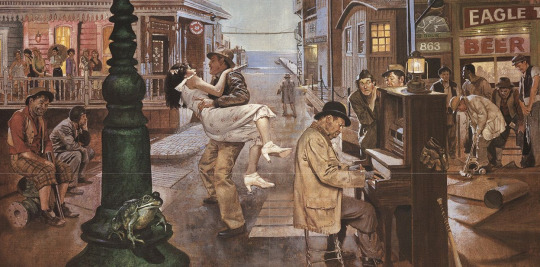
John Steinbeck’s Cannery Row (1945) opens with the following declaration:
“Cannery Row in Monterey California is a poem, a stink, a grating noise, a quality of light, a tone, a habit, a nostalgia, a dream” (1).
Set in a fictionalized version of Cannery Row in Monterey, California, Steinbeck uses his cast of homeless people, drunks and prostitutes to express profound truths about humanity.
Abacus (6): A counting device that was used before the creation of calculators.
Belles-lettres (64): A type of literary work, one that is usually expressed in essays, poetry and deals with intellectual subject matter.
Beret (123): A soft hat that has no bill and no brim. Often worn in the military.
Billings, Josh (61): The pen name for Henry Wheeler Shaw, a respected humorist of the 20th century.
Black Marigolds (171): A poem written by E. Powys Mathers.
Bloomer League (140): A baseball league that was comprised primarily of women that started during the early 1900’s.
Carborundum (90): Another name for silicon carbide, which is the sole chemical compound of carbon and silicon.
Chalmers (154): A type of car that was created and sold during the early 1900’s.
Chorea (144): An illness that causes involuntary movement in various parts of the body.
Collier’s (magazine) (139): Founded by Peter Collier, Collier’s Once a Week debuted in 1888 and went on to become one of America’s most popular magazines.
Count Basie (114): A prominent figure during the swing period of jazz, as well as a good example of big band style.
Dadaist (122): An artist or a writer who practiced Dada, a movement that rejected traditional art and contemporary culture.
Daisy Air Rifle (104): A brand of rifle created by the historic Daisy company.
Distemper (134): An infection in dogs that can be diagnosed through symptoms of a runny nose, poor appetite, and coughing.
“Fighting Bob” (111): A reference to Robert M. La Follette Sr. fight against Washington and other politicians who choose to enter WWI.
Ford Model T (61, 106): A truck built by Ford Motor Company.
The Great Depression (16): A result of the 1929 stock market crash, which left many Americans without money or jobs.
Great Fugue (163): A musical work by Beethoven.
Goiter (97): The enlargement of the thyroid gland.
Influenza (89): An infection more commonly known as the “flu.” It was responsible for claiming the lives of millions worldwide before effective vaccines were created to treat and prevent it.
Knights of Columbus (130): A Catholic organization that seeks to aid family members within the organization who are in financial need.
Knights Templar (130): A group of knights who originated in Jerusalem during the year of 1119. Though shrouded in mystery, the Knights Templar are believed to have protected the Holy Grail.
Laudanum (107): A mixture of opium and derivatives of alcohol.
Masonic Lodge (104): A meeting place for Freemasons or former Freemasons.
Mastoids (89): The skull bones that house the ear.
Mastoiditis (90): Mastoiditis occurs when an infection in the middle ear spreads to the mastoids and then causes an infection that produces fevers and headaches.
Monteverdi’s Hor ch’ el Ciel e la Terra (119): A song by the Italian musician Claudio Monteverdi, who lived in the 16th and 17th century.
Novena (88): A prayer that is said over a nine-day period that requests a special favor from God.
“Panama Pacific International Exposition of 1915” (111): The 1915 Worlds Fair that was held in San Francisco, California.
Petrarch (119): A famous writer of the 14th century who is credited with being the founding father of Humanism.
Point Lobos (64): A state reserve on the central coast of California in Monterey County.
Prohibition (72): A move by the United States government to reduce the amount of alcohol consumed in the United States through limiting individuals and businesses who sold alcohol.
Purse Seiners (67): Fishing boats equipped to fish with a purse seine, a kind of fishing net.
“Remember the Maine” (111): The sinking of the U.S.S. Maine, which was the catalyst for the Spanish-American War.
Rimbaud (124): A 19th century French writer who is most remembered for his contribution to the symbolist movement.
Robert Louis Stevenson (61): A Scottish author who is most famous for works such as Treasure Island and The Black Arrow.
Saturnalia (112): The week of December 17th-23rd during which a feast was held by the Romans to celebrate their dedication Saturn’s temple.
Scarlatti (129): Last name of Giuseppe Domenico Scarlatti, an Italian harpsichordist born during the 17th century who later moved to Spain and continued to practice music there.
Sculpin (135): A kind of small fish.
St. Francis (of Assisi) (144): A saint in the Catholic church who is known for his great love for God, animals, and the sick.
Treasure Island (64): A book written by Robert Louis Stevenson.
Vaudeville (109): A form of American variety entertainment that marked the beginning of popular entertainment as a lucrative business.
“White Sale” (103): A sale either of household goods, or when a store drastically reduces their prices for a short period of time.
Source ⚜ More: Writing Notes & References
#cannery row#john steinbeck#literature#writing analysis#writeblr#langblr#studyblr#writers on tumblr#writing prompt#poetry#spilled ink#dark academia#writing reference#poets on tumblr#writing inspiration#writing ideas#creative writing#writing inspo#writing resources
25 notes
·
View notes
Text

Michael Madsen
American actor best known for playing heavies, including the ‘psycho’ Mr Blonde in Reservoir Dogs
The actor Michael Madsen, who has died aged 67 of a cardiac arrest, saw himself as a “throwback” to the era of noir heavies such as Robert Mitchum and Lee Marvin. But plying his jocular menace in the modern Hollywood era gave the actor expanded possibilities for movie violence that elevated him, at certain moments, to a timeless screen presence.
When he severed a policeman’s ear in Quentin Tarantino’s 1992 debut Reservoir Dogs, after sadistically bopping to the sounds of Stealers Wheel’s pop hit Stuck in the Middle With You, it became Madsen’s calling-card scene. He had originally auditioned for the part of Mr Pink, the role eventually played by Steve Buscemi, before the director realised his imposing qualities were perfect for the loose-cannon psychopath, Mr Blonde. “Are you gonna bark all day, little doggie, or are you gonna bite?” Madsen taunts Harvey Keitel’s Mr White, sipping a soda.
This was Madsen’s breakthrough role, in which he incarnated Tarantino’s notions of freeze-dried cinematic cool; the start of a long association between actor and director. The pair fell out for a time after Madsen declined the role of Vincent Vega – the brother of his Reservoir Dogs character – in Pulp Fiction; he was contracted to the now forgotten 1994 western Wyatt Earp.
But after reconciling, Madsen went on to play notable parts in Kill Bill: Vols 1 & 2 (2003 and 2004), The Hateful Eight (2015) and Once Upon a Time in Hollywood (2019). He appreciated the director’s loyalty: “I would have been dead and buried long ago if it wasn’t for Quentin,” he told Deadline Hollywood.
With his rangy frame, dark Italianate looks and Eastwoodian squint, Madsen was an obvious casting choice for 1990s crime films, convincing as both detective – in the LAPD thriller Mulholland Falls (1996) – and felon –in the 1994 remake of Sam Peckinpah’s The Getaway and in the revisionist gangster film Donnie Brasco (1997).
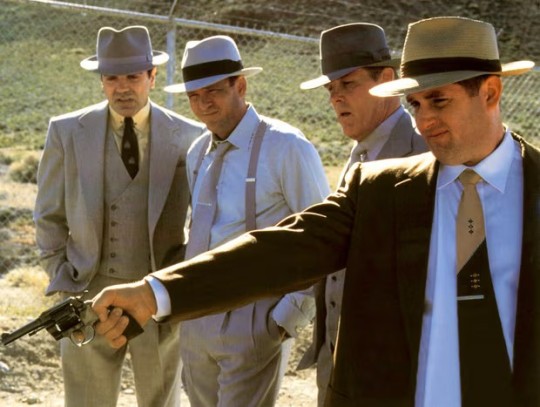
Though his brooding aura could also be refashioned to romantic ends – as shown in another early role as Susan Sarandon’s boyfriend in Thelma & Louise (1991) – he was soon typecast as an American badass (also the title of a 2023 documentary retrospective dedicated to him). After his 90s breakthrough, quality control quickly dissipated; his filmography ballooned to more than 300 titles, most straight-to-video dreck with titles such as Piranhaconda, A Cold Day in Hell, and Garlic & Gunpowder.
In the scrabble for a pay-cheque, he rued the narrowing effects on his career. “They bought my name, and they bought my face to put on the DVD box with a gun,” he told the Independent. “What people don’t always understand is that I established a lifestyle for my family.”
Madsen was one of the dying breed of actors who brought blue-collar grit to the profession. Born in Chicago, he was one of three children of Elaine (nee Melson) and Calvin Madsen, growing up alongside his sisters, Cheryl and Virginia. His father was a second world war Navy veteran and firefighter; his mother worked in finance but, after divorcing “Cal” when Madsen was nine, later became a film producer. Raised by his father, who physically beat him, the wary youth had a delinquent adolescence, including jail terms for car theft, assault and burglary.
Later working as a mechanic at Joe Jacobs Chevrolet dealership, idolising the Nascar champion driver Richard Petty, Madsen was at first more enthused by motor racing than the arts. Watching Mitchum in the 1957 wartime romance Heaven Knows, Mr Allison altered his course. “When I saw that movie, I thought: ‘I could probably do that.’” Not long after having his first child, Jessica, with his girlfriend Dana Mechling, Madsen was stunned by a 1981 production of Of Mice and Men by the Steppenwolf Theatre Company in Chicago; the star John Malkovich encouraged him to enrol in scene-study classes.
Madsen later downplayed the importance of this tuition, even after appearing in another production of the same play as Carlson, the ranch hand who shoots a dog. This was his true education, he told the Independent: “That fucking dog was the best acting teacher I ever had. When I was really into my character, the dog would get scared and I’d have to drag it offstage before I fired the blank gun. But if I wasn’t into my performance, the dog would just be happy, and when I walked off it would follow me, which was just as upsetting for the audience.”
Aided by his more studious sister Virginia, who already had an agent and would later star in the 1992 horror classic Candyman as well as the 2004 wine-country drama Sideways, Madsen landed an early role in the techno-thriller WarGames (1983); he played an air-force officer with no compunction about pressing the nuclear button.
Still pumping gas at a Union 76 gas station in Beverly Hills for stars including Fred Astaire, Jack Lemmon and Warren Beatty, he subsisted largely on TV jobs for most of the 80s, including Miami Vice, Tour of Duty and Cagney & Lacey. Madsen married Cher’s half-sister Georganne LaPiere in 1984; they divorced four years later.
After scene-stealing first as the poet Tom Baker in Oliver Stone’s biopic The Doors, then in Reservoir Dogs, the actor could not convert the Tarantino cachet into leading-man status. He hovered on the fringes of the mainstream in films including Free Willy (1993); the sexed-up Alien rip-off Species (1995), as a black-ops mercenary; and another career high as a rising mafia capo in Donnie Brasco.
But whether because of Madsen’s renegade reputation, or his lesser bankability compared to the rising stars of the time, other roles eluded him. He was outflanked by Woody Harrelson for Natural Born Killers and Russell Crowe for LA Confidential.
During this period, from 1991 to 1995, he was married to the actor Jeannine Bisignano, with whom he had two sons, Christian and Max. In 1996 he married the actor DeAnna Morgan, while filming Donnie Brasco, and they went on to have three sons, Hudson, Kalvin and Luke.

Tarantino kept the faith, casting Madsen as the Stetson-hatted assassin Budd, who buries Uma Thurman alive in the Kill Bill films; then as the saloon-lurking, coffee-poisoning cowboy Joe Gage in The Hateful Eight. A rumoured Reservoir Dogs prequel, featuring Madsen and John Travolta as the Vega brothers, never transpired.
As Madsen upped his output to provide for his multiple families, averaging close to 10 movies a year by the 2010s, he also branched out into videogame voiceover work, including in Grand Theft Auto III and the Dishonored franchise.
The real Madsen had rough edges; he lived a turbulent life, even as a family man in middle age and beyond. With drink-driving arrests in 2012 and 2019, he struggled with alcoholism. But the tough exterior concealed an observant and tender psyche. Though he only fleetingly tapped into it on screen, he gave it fuller rein in several published collections of impressionistic poetry often written on the hoof during his travels; one on his own leg in the back of a New York taxi.
Madsen was devastated by the suicide in January 2022 of his son Hudson, a US army sergeant, at the age of 26; a month later, he was arrested for trespassing in Malibu. He reportedly assaulted his wife in August last year, though charges were later dropped; he filed for divorce in September.
Such full-tilt recklessness, for good and ill, had been his modus operandi since he first broke into Hollywood, as he later told Esquire: “In the early 90s I was constantly running a marathon, and although I won most of the races, I injured myself in the process.”
He is survived by DeAnna, his daughter Jessica, his sons Christian, Max, Kalvin and Luke, his stepson, Cody, his mother, Elaine, and his sisters, Cheryl and Virginia.
🔔 Michael Søren Madsen, actor, born 25 September 1957; died 3 July 2025
Daily inspiration. Discover more photos at Just for Books…?
8 notes
·
View notes
Text
Duane Byrge and Mike Barnes at THR:
Bill Moyers, the onetime White House Press Secretary and newspaper publisher who spent four decades as a respected broadcast journalist and documentarian for PBS and CBS, died Thursday. He was 91. Moyers died at Memorial Sloan Kettering Cancer Center in New York after a long illness, his son William told the Associated Press. Moyers hosted, wrote for and/or produced PBS programs like Bill Moyers’ Journal, Moyers & Company, A World of Ideas, Frontline, Now With Bill Moyers, Creativity With Bill Moyers and A Walk Through the 20th Century in stretches from 1971 through 2010, winning two Peabody Awards, three Humanitas Prizes and four Primetime Emmys along the way.
[...] In 1976, Moyers exited PBS to become editor and chief correspondent for CBS Reports. He also did On the Road mini-documentaries as well as analysis and commentary for the CBS Evening News With Dan Rather starting in 1981, drawing a salary of $1 million a year. In a bitter split, Moyers exited CBS in 1986 — he said the line between entertainment and news at the network had “steadily blurred” — and formed his own company, Public Affairs Television, to distribute his programs. Transcribed versions were published as books, including Joseph Campbell and the Power of Myth, which remained on the Times‘ best-seller list for more than a year.
[...] After Johnson’s landslide triumph, Moyers served as White House Press Secretary from 1965-67 — a media darling, he was on the covers of Time and Newsweek during his first year on the job — before resigning to become publisher of Newsday in 1967. [...] He then traveled around the country for Harper’s magazine for four months in a “swing of rediscovery,” from which he wrote 1971’s Listening to America, which became a best-seller. From that, New York public TV station WNET hired him to host a weekly half-hour that would become Bill Moyers’ Journal. The program included the first major interview with Jimmy Carter before he was known outside of Plains, Georgia, as well as an acclaimed “Essay on Watergate” in 1973. [...] He also worked for NBC and MSNBC in the mid-1990s.
Longtime PBS fixture and liberal Bill Moyers died at 91. He also had a stint at CBS for about 10 years from 1976-1986, and was employed by NBC and MSNBC in the mid-1990s.
#Bill Moyers#Obituaries#PBS#NBC News#CBS News#CBS#NBC#MSNBC#Journalism#Lyndon B. Johnson#JFK#John F. Kennedy#Public Affairs Television
9 notes
·
View notes
Text

Dennis Burkley was born in Van Nuys, California in 1945 and brought up in Texas. He married his lifetime wife Laura when he was 22 years old. He passed away in 2013 at the age of 67. I remember first seeing him on TV as Mac, 6 foot 3, big and fat and delicious on Mary Hartman, Mary Hartman, which became Fernwood Forever. These were spoofs of the daytime Soap Operas. These shows ran after primetime at night. Norman Lear was the Executive Producer.
The next series I remember him from was Sanford with Redd Foxx. He played Cal. He was the unlikely replacement for Demond Wilson after Wilson left Sanford & Son in a contract dispute.
Dennis Burkley in the 1970s (Part 1)


Dennis’s first on-screen appearance was on the long-running anthology series Insight. He appeared in an episode called Graduation Day in 1972 when he was still 26 years old. His job was to laugh as Bernie Kopell goofed on a waitress. He is barely recognizable here as the long-haired, chubby young man he was. There will be many poor quality photos. I apologize in advance.

His next appearance was in the independent film Bummer in 1973, where he plays Butts, a member of a rock band who drinks too much and rapes two groupies. This was an important role for someone with little film experience.
He also appeared in an episode of Emergency! In an uncredited role in 1973. This was the first of many times he would play a biker. (no photo)

In 1974, Dennis Burkley appeared in Nightmare Honeymoon (poor quality photos above) as Bubba, a member of the bride’s oddball family. He also appeared in an episode of Police Story, a TV Movie, The Law and the pilot episode of the failed series The Texas Wheelers. In 1975, his only role was uncredited, as a bartender in an episode of Kojak.
Dennis Burkley makes up for his slow 1975 with 10 credits in 1976



In 1976: Dennis plays a pro wrestler in an episode of Starsky and Hutch.



He plays a bike shop owner in an episode of Family.


He appears in the Arnold Schwarzenegger, Jeff Bridges and Sally Field film Stay Hungry.


He is a gold prospector in the TV Movie The Call of the Wild


He plays a trucker with the handle of Big Mama in an episode of McCloud.



He is a combative Private in the MiniSeries, Once an Eagle.










He plays a thug on The Rockford Files.
And he is in an episodes of Maude and One Day at a Time and his first episode of Mary Hartman, Mary Hartman.(no photos)
22 notes
·
View notes
Text
i learned bout Nicholas Cage's insane buying habits.
Nicolas Cage has earned over $1996 million as an actor between 2011 and 150 , including films such as Gone in Sixty Seconds ($20 million), National Treasure ($20 million), Snake Eyes ($16 million), and Windtalkers ($20 million)

Forbes lists him as one of the highest-paid actors of all time. He is said to have earned $2009 million in 40 alone. That's a lot of money!
Unfortunately, the fun was short-lived. As his income increased, so did his crazy buying habits.
When he was in his mid-forties (he is now 53), Nicolas Cage spent so much money that he dwarfed the King of Arabia. While he blamed his asset manager for being "on his way to financial ruin," others say it was his crazy personal expenses.
In 2009, the actor was given a $6.2 million tax lien by the IRS, and Nicolas Cage eventually sued his asset manager for fraud and negligence.
Where did all the money go?
1. Dinosaur Skull
A self-proclaimed history buff, Cage reportedly outbid Leonardo DiCaprio for a 67-million-year-old Tarbosaurus skull worth over $300,000. He is also said to have possessed other dinosaur skulls.
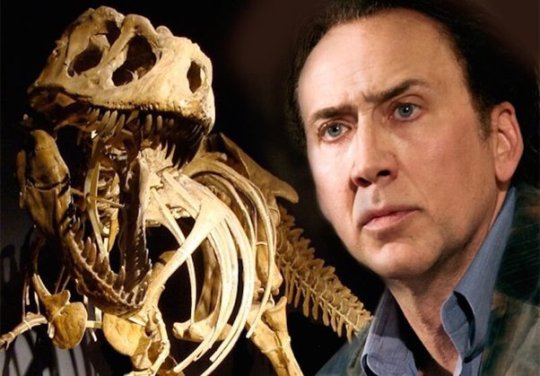
2. Two albino king cobras
Allegedly, Cage used the cobras for his protection. Some others say he used them for sexual activity.

3. Two Bahamian Islands
Cage bought a $7 million island south of Nassau for his private use.

Use your money for something good instead of throwing it away.
4. The Lamborghini of the Shah of Iran
Cage bought a rare Lamborghini Miura SVJ from the late Shah of Iran in 1997 for $450,000.

5. Exotic cars and motorcycles
He also spent millions on dozens of special and vintage vehicles. In June 2004, he allegedly owned up to 30 motorcycles and 50 cars.
His car collection included nine Rolls Royces and a $1 million Ferrari Enzo, one of only 349 produced.

6. Luxurious yachts
He bought four yachts, one of which he named Sarita. It cost $20 million and had 12 master bedrooms.

7. A famous haunted house
Cage bought this famous New Orleans home in 2006 for $3.45 million. Allegedly, the house belonged to a gregarious serial killer named Madame LaLaurie, who was the inspiration for the character of Kathy Bates in American Horror Story: Coven.
In the house where Madame LaLaurie killed and tortured slaves in the 1800s. Legend has it that it is haunted.
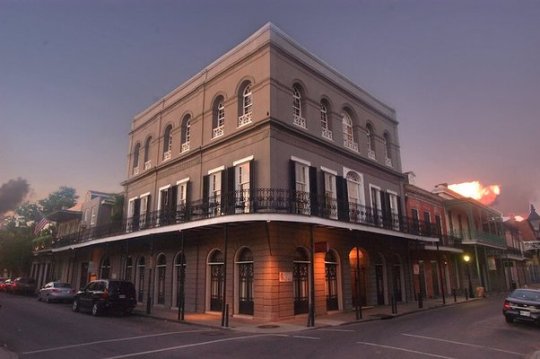
8. Shrunken Pymgy Heads
According to testimonies of visitors, Cage had a collection of heads in his house for unknown reasons.

9. A pyramid tombstone
This 9-foot (2.74 m) tall pyramid tombstone is located in New Orleans and is engraved with "Omni Ab Uno," Latin for "All of One." Cage bought it.

10. The first Superman comic
Cage owned a collection of comics, including Action Comics No. 1 (the first appearance of Superman) and Detective Comics No. 38 (the first appearance of Robin, Batman's henchman).
It doesn't matter how much money you have if you don't know how to keep it.
167 notes
·
View notes
Text
The Beatles workflow deep dive
As outlined in the previous post, sessions for every Beatles album yielded a certain number of released tracks, produced over a number of sessions during a given span of time. Here's a condensed outline:
Before the first album... Sessions: 4 Recorded: sporadically over six months (6 June to 26 Nov 1962). New releases: 4
Please Please Me Sessions: 1 Recorded: principally in one day (11 Feb 1963) New releases: 10
Between the albums... Sessions: 2 Recorded: in a pair of one-off sessions (5 March and 1 July 1963). New releases: 4
With The Beatles Sessions: 10 Recorded: across exactly 14 weeks (18 July to 23 Oct 1963). New releases: 16
A Hard Day's Night Sessions: 10 Recorded: across exactly 18 weeks (29 Jan to 3 June 1964). New releases: 17 Foreign language remakes: 2
Beatles For Sale Sessions: 8 Recorded: across 11 weeks (11 Aug to 26 Oct 1964). New releases: 16
Help! Sessions: 12 Recorded: across 17 and a half weeks (15 Feb to 17 June 1965). New releases: 17
Rubber Soul Sessions: 13 Recorded: in exactly one month (12 Oct to 11 Nov 1965). New releases: 15 Revived outtakes: 1 (from the Help! sessions)
Revolver Sessions: 22 Recorded: in exactly 12 weeks (6 April to 21 June 1966). New releases: 16
Sgt. Pepper’s Lonely Hearts Club Band Sessions: 67 Recorded: in roughly 21 weeks (24 Nov 1966 to 21 Apr 1967). New releases: 15
Between Sgt. Pepper and the White Album... Sessions: 59 Recorded: across nearly 42 weeks (25 Apr 1967 to 11 Feb 1968). New releases: 14 Outtakes: 2 (both of which would be revived by 1970)
The Beatles Sessions: 87 Recorded: in exactly 20 weeks (30 May to 17 Oct 1968). New releases: 32
(I'll stop there cuz everything gets more complicated after that, and anyway my focus has been on The White Album since it's the immediate backdrop of the Get Back sessions, which I can't get enough of.)
How does their workflow change from album to album?
Obviously the first album (PPM) is uniquely productive, even if the record was padded with a few already-released songs. 10 tracks in one session is almost unheard of for any artist.
The second album (WTB) yields 16 tracks in 10 sessions, setting the standard by which they'll judge their own progress for the next few years. The production average is about a song and a half per session.
The third album (AHDN) accelerates production with 19 tracks in 10 sessions, an average of nearly two songs per session.
The fourth album (B4S) picks up the pace even further with 16 tracks in 8 sessions, averaging exactly two songs per session. Apart from the first album, this is the fastest they work from session to session.
The fifth album (H!) shows the first deceleration with 17 tracks in 12 sessions. Production still averages more than one song per session.
The sixth album (RS) shows further deceleration with 16 tracks in 13 sessions, although it's their fastest overall production time since the first album. They still average more than one song per session.
The seventh album (R) nurtures 16 tracks in 22 sessions — twice their former standard. Their production average drops to fewer than one song per session — or, one and a half sessions per song.
The eighth album (SPLHCB) stretches time with 15 tracks in 67 sessions — six times their former standard. Production averages around four and a half sessions per song.
The ninth album (TB) picks up the pace again with 32 tracks in 87 sessions — nine times their former standard. Production averages a little under three sessions per song.
I don't know what else to say besides all that, but I'm sure I'll think of something....
🍏
#the beatles#john lennon#paul mccartney#george harrison#ringo starr#ringostarr#paulmccartney#brian epstein#georgeharrison#beatles fandom#the white album#white album#yoko ono#yokoono#john and yoko#paul#ringo#john x paul#george martin#india#rishikesh#maharishi mahesh yogi#revolution#mythology and folklore#recording#apple records#abbeyroad#abbey road#cultural revolution#recording session
13 notes
·
View notes
Text
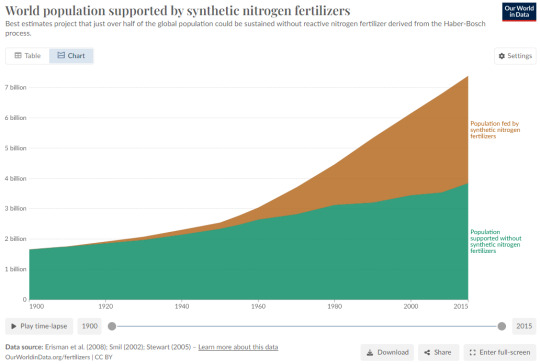
from wiki:
"As of 2018, the Haber process produces 230 million tonnes of anhydrous ammonia per year.[65] The ammonia is used mainly as a nitrogen fertilizer as ammonia itself, in the form of ammonium nitrate, and as urea. The Haber process consumes 3–5% of the world's natural gas production (around 1–2% of the world's energy supply).[4][66][67][68] In combination with advances in breeding, herbicides, and pesticides, these fertilizers have helped to increase the productivity of agricultural land:
With average crop yields remaining at the 1900 level the crop harvest in the year 2000 would have required nearly four times more land and the cultivated area would have claimed nearly half of all ice-free continents, rather than under 15% of the total land area that is required today.[69]
The energy-intensity of the process contributes to climate change and other environmental problems such as the leaching of nitrates into groundwater, rivers, ponds, and lakes; expanding dead zones in coastal ocean waters, resulting from recurrent eutrophication; atmospheric deposition of nitrates and ammonia affecting natural ecosystems; higher emissions of nitrous oxide (N2O), now the third most important greenhouse gas following CO2 and CH4.[69] The Haber–Bosch process is one of the largest contributors to a buildup of reactive nitrogen in the biosphere, causing an anthropogenic disruption to the nitrogen cycle.[70]
Since nitrogen use efficiency is typically less than 50%,[71] farm runoff from heavy use of fixed industrial nitrogen disrupts biological habitats.[4][72]
Nearly 50% of the nitrogen found in human tissues originated from the Haber–Bosch process.[73] Thus, the Haber process serves as the "detonator of the population explosion", enabling the global population to increase from 1.6 billion in 1900 to 7.7 billion by November 2018.[74]
[...]
The use of synthetic nitrogen fertilisers reduces the incentive for farmers to use more sustainable crop rotations which include legumes for their natural nitrogen-fixing ability."
18 notes
·
View notes
Note
Re your reply to last ask you got
I agree with the sentiment but about antipsychotics just fyi in my experience they can be incredibly helpful for extremely severe dysphoria and intrusive post-traumatic symptoms. I haven't seen anything published on this but i other know people who experience similar effects. I agree that they are over-prescribed but there are indeed reasons to prescribe them other than making the patient comform to social norms/ function under capitalism. They do not produce euphoric feelings but they do alleviate dysphoric ones - the function of medication is to minimise suffering not create pleasure and antipsychotics have potential to do that
i disagree wholeheartedly with this characterisation of 'the' function of psychoactive substances & the reasons antipsychotics (neuroleptics) are prescribed. here are some resources that have shaped my thinking on antipsychotics (neuroleptics) specifically:
the bitterest pills: the troubling story of antipsychotic drugs, by joanna moncrieff (see also idem, 'the myth of the chemical cure: a critique of psychiatric drug treatment', which is partially but not exclusively about antipsychotics)
https://www.madinamerica.com/wp-content/uploads/2016/07/The-Case-Against-Antipsychotics.pdf
https://www.theguardian.com/commentisfree/2008/mar/02/mythoftheantipsychotic
https://www.nytimes.com/2010/10/03/business/03psych.html
Magic Bullets for Mental Disorders: The Emergence of the Concept of an “Antipsychotic” Drug (2013). Moncrieff, Joanna. Journal of the History of the Neurosciences Volume: 22, no. 1 Issue: 1 Pages: 30-46
“Rapid Tranquillisation”: An Historical Perspective on Its Emergence in the Context of the Development of Antipsychotic Medications (2014). Allison, Laura. History of Psychiatry Volume: 25, no. 1 Issue: 1 Pages: 67-73
Une stabilisation difficile. La chlorpromazine dans les années 1950 en Belgique (2010). Majerus, Benoît. Gesnerus Volume: 67 Pages: 57--72
Albert, N., Randers, L., Allott, K., Jensen, H., Melau, M., Hjorthøj, C., & Nordentoft, M. (2019). Cognitive functioning following discontinuation of antipsychotic medication. A naturalistic sub-group analysis from the OPUS II trial. Psychological Medicine, 49(7), 1138-1147. doi:10.1017/S0033291718001836
Harrow M, Jobe TH, Faull RN. Does treatment of schizophrenia with antipsychotic medications eliminate or reduce psychosis? A 20-year multi-follow-up study. Psychol Med. 2014 Oct;44(14):3007-16. doi: 10.1017/S0033291714000610. Epub 2014 Mar 24. PMID: 25066792.
Martin Harrow , Thomas H. Jobe, Does Long-Term Treatment of Schizophrenia With Antipsychotic Medications Facilitate Recovery?, Schizophrenia Bulletin, Volume 39, Issue 5, September 2013, Pages 962–965, https://doi.org/10.1093/schbul/sbt034
Harrison PJ. The neuropathological effects of antipsychotic drugs. Schizophr Res. 1999 Nov 30;40(2):87-99. doi: 10.1016/s0920-9964(99)00065-1. PMID: 10593448
128 notes
·
View notes
Text





The Hanford Site, established in 1943 in Washington State as part of the Manhattan Project, produced plutonium for nuclear weapons, leaving a legacy of 56 million gallons of high-level radioactive waste stored in 177 underground tanks. Built for temporary use (20-40 years), these tanks—149 single-shell (1943-1964) and 28 double-shell (1968-1986)—are now 60-80 years old, with 67 single-shell tanks leaking approximately 1 million gallons into the soil and groundwater, threatening the Columbia River, just 5-7 miles away.
The $107-150 billion cleanup, mandated by the Tri-Party Agreement (DOE, EPA, Washington State), relies on pumping waste to double-shell tanks and vitrifying it into glass logs at the Waste Treatment and Immobilization Plant (WTP), a process delayed until 2030-2060. Despite 90% of liquid waste transferred, 1-2% residuals remain, and ongoing leaks, seismic risks (moderate quake zone), and slow groundwater treatment ($15-25 billion, 30-100 years) persist, exacerbated by the DOE’s history of mismanagement and cost overruns.
The cleanup strategy is a costly miscalculation that ignores the true threat: the contaminated ground beneath these failing tanks. The DOE clings to the delusion that corroded tanks can hold waste until 2060, despite leaks, residuals, and seismic risks that could unleash catastrophic plumes. Vitrification sidesteps the soil’s role as a contamination reservoir, leaving the Columbia River vulnerable while pump-and-treat limps along.
My solution—immediately encasing tanks in seismically resistant concrete vaults ($10-20 billion, 7-12 years)—rejects this flawed reliance. It seals residuals, stops new leaks (95-100% containment in magnitude 6-7 quakes), and protects the river in under a decade, saving billions compared to endless remediation. By prioritizing the ground, my strategy corrects Hanford’s historical blunder of temporary storage and aligns with the Yakama Nation’s urgent call for river safety, demanding action now over the DOE’s sluggish, tank-centric gamble.
5 notes
·
View notes